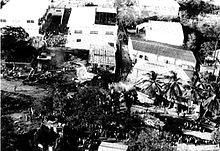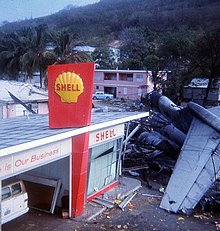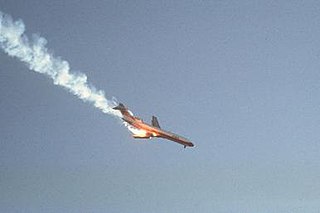
Pacific Southwest Airlines Flight 182 was a scheduled flight of Pacific Southwest Airlines (PSA) from Sacramento to Los Angeles and San Diego. On September 25, 1978, the Boeing 727-214 serving the flight, registration N533PS, collided with a private Cessna 172 light aircraft, registration N7711G, over San Diego, California. It was Pacific Southwest Airlines' first fatal accident, and it remains the deadliest air disaster in California history. At the time, it was the deadliest air crash to occur in the United States, and remained so until American Airlines Flight 191 in May 1979.

Santa Barbara Municipal Airport is 7 miles (11 km) west of downtown Santa Barbara, California, United States. SBA covers 948 acres of land and has three runways.

Delta Air Lines Flight 1141 was a scheduled domestic passenger flight between Dallas/Fort Worth, Texas and Salt Lake City, Utah. On August 31, 1988, the flight, using a Boeing 727-200 series aircraft, crashed during takeoff, resulting in 14 deaths and 76 injuries of the 108 on board.

Allegheny Airlines was a regional airline that operated out of Pittsburgh, Pennsylvania, from 1952 to 1979 with routes primarily located in the eastern U.S. It was the forerunner of USAir that was subsequently renamed US Airways, which itself merged with American Airlines. Its headquarters were at Washington National Airport in Arlington County, Virginia.

Pan Am Flight 759 was a regularly scheduled domestic passenger flight from Miami to San Diego, with en route stops in New Orleans and Las Vegas. On July 9, 1982, the Boeing 727 flying this route crashed in the New Orleans suburb of Kenner after being forced down by a microburst shortly after takeoff. All 145 on board, as well as 8 people on the ground, were killed.
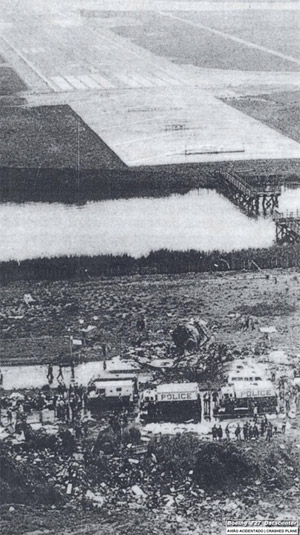
Eastern Air Lines Flight 66 was a regularly scheduled flight from New Orleans to New York City that crashed on June 24, 1975 while on approach to New York's John F. Kennedy International Airport, killing 113 of the 124 people on board. The crash was determined to be caused by wind shear caused by a microburst, but the failure of the airport and the flight crew to recognize the severe weather hazard was also a contributing factor.

Billings Logan International Airport is in the western United States, two miles northwest of downtown Billings, in Yellowstone County, Montana. It is the fourth largest airport in Montana, having been surpassed in recent years by Bozeman, Missoula, and Flathead County (Kalispell) in both number of gates as well as annual enplanements. Owned by the city of Billings, the airport is on top of the Rims, a 500-foot (150 m) cliff overlooking the downtown core, and covers 2,500 acres of land.

Cyril E. King Airport is a public airport located two miles (3 km) west of the central business district of Charlotte Amalie on the island of St. Thomas in the United States Virgin Islands. It is currently the busiest airport in the United States Virgin Islands, and one of the busiest in the eastern Caribbean, servicing 1,403,000 passengers from July 2015 through June 2016. The airport also serves the island of St. John and is additionally often used by those travelling to the nearby British Virgin Islands.

United Airlines Flight 389 was a scheduled flight from LaGuardia Airport, New York City, New York, to O'Hare International Airport, Chicago, Illinois. On August 16, 1965, at approximately 21:21 EST, the Boeing 727 crashed into Lake Michigan 20 miles east of Fort Sheridan, near Lake Forest, while descending from 35,000 feet (11,000 m) mean sea level (MSL). There was no indication of any unusual problem prior to impact. All 30 persons aboard, including six crew members and 24 passengers, were killed.

American Airlines Flight 383 was a nonstop flight from New York City to Cincinnati on November 8, 1965. The aircraft was a Boeing 727, with 57 passengers, and 5 crew on board. The aircraft crashed on final approach to the Cincinnati/Northern Kentucky International Airport located in Hebron, Kentucky, United States. Only three passengers and one flight attendant survived the crash.

Piedmont Airlines Flight 22 was a Piedmont Airlines Boeing 727-22 that collided with a twin-engine Cessna 310 on July 19, 1967, over Hendersonville, North Carolina, United States. Both aircraft were destroyed and all passengers and crew were killed, including John T. McNaughton, an advisor to U.S. Secretary of Defense Robert McNamara. The aircraft were both operating under instrument flight rules and were in radio contact with the Asheville control tower, though on different frequencies. The accident investigation was the first of a major scale conducted by the newly created National Transportation Safety Board. A review of the investigation conducted 39 years after the crash upheld the original findings that had placed primary responsibility on the Cessna pilot.

On 22 December 2009, an American Airlines Boeing 737-800, operating American Airlines Flight 331 and carrying 148 passengers and six crew, overran runway 12 on landing at Kingston in poor weather. The plane continued on the ground outside the airport perimeter and broke apart on the beach, causing injuries.

On December 27, 1968, North Central Airlines Flight 458 crashed into a hangar while attempting a night landing in poor weather at O'Hare International Airport in Chicago, Illinois, in the United States. Of the 41 passengers and four crew members, only 17 passengers and one crew member survived. One person was killed and six were injured on the ground.
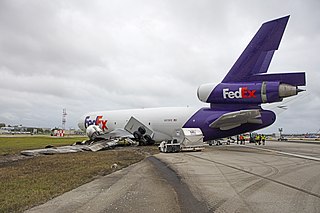
On October 28, 2016, FedEx Express Flight 910, a McDonnell Douglas MD-10-10F flying from Memphis International Airport to Fort Lauderdale–Hollywood International Airport was involved in a runway skid after a landing gear collapse, which resulted in a fire completely destroying the left engine and wing. Two crew members, the only people on board, were unharmed.

The crash of Alaska Airlines Flight 60 was an accident involving a Boeing 727-81 of the American airline Alaska Airlines at Ketchikan International Airport in Ketchikan, Alaska, United States, on April 5, 1976, resulting in the death of a passenger with 32 serious and 17 minor injured survivors among the initial 50 passengers and crew on board.
